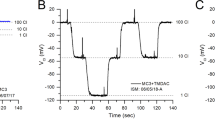Abstract
Manufacture, properties and use of a micro enzyme electrode for continuous monitoring of volume fluxes in the isolated tubule preparation is described. The specific electrode is a galactose-oxidase enzyme electrode, which can be used to detect changes in raffinose concentrations. The electrode's response to raffinose is almost linear over concentrations from 0–12 mmol/l. The electrode equally responds to galactose as to raffinose but is insensitive to other sugars, to pH changes (from 6.0–8.0), CO2 (from 1–10%) and electrolytes tested. Reducing O2 from 100 to 10% and to 1%, leads to a reduction of the reading by 10% and 30%, respectively. The reading is almost doubled when the temperature is increased from 20–40° C. Furthermore, reducing agents such as uric acid and ascorbic acid interfere with the reading. If these substances and raffinose are omitted from the perfusate for isolated perfused proximal mouse tubules, the reading is identical in perfusate and collected fluid, indicating that the tubular epithelium does not produce substances in sufficient amounts to interfere with the electrode reading. After addition of 6 mmol/l raffinose to the perfusate the raffinose concentration in the collected fluid of 0.76±0.05 mm segments of straight proximal mouse tubules (perfusion rate = 3.4±0.45 nl/min) is 10.2±0.3 mmol/l, indicating a volume reabsorption of 1.5±0.3 nl/min. Peritubular application of acetazolamide reduces the volume reabsorption by 42±4%.
Similar content being viewed by others
References
Adlercreutz P, Mattiasson B (1982) Oxygen supply to immobilized biocatalysts. A model study. Acta Chem Scand 36:651–653
Burg M, Grantham J, Abramov M, Orloff J (1966) Preparation and study of fragments of single, rabbit nephrons. Am J Physiol 10:1293–1298
Burg M, Green N (1977) Bicarbonate transport by isolated perfused rabbit proximal convoluted tubules. Am J Physiol 233:F307-F314
Clark LC, Lyons C (1962) Electrode systems for continuous monitoring in cardiovascular surgery. Ann NY Acad Sci 102:29–45
Gertz KH (1963) Transtubuläre Natriumchloridflüsse und Permeabilität für Nichtelektrolyte im proximalen und distalen Konvolut der Rattenniere. Pflügers Arch 276:336–356
Gibson QH, Swoboda EP, Massey V (1964) Kinetics and mechanism of action of glucose oxidase. J Biol Chem 239:3927–3934
Gough DA, Leypoldt JK (1981) Theoretical aspects of enzyme electrode design. Applied Biochem Bioeng 3:175–206
Greger R, Hampel W (1981) A modified system for in vitro perfusion of isolated renal tubules. Pflügers Arch 389:175–176
Guilbault GG (1981) Applications of enzyme electrodes in analysis. Ann NY Acad Sci 369:285–294
Guilbault GG, Lubrano GJ (1973) An enzyme electrode for the amperometric determination of glucose. Anal Chimica Acta 64:439–455
Johnson JM, Halsall UB, Heineman WR (1982) Potential dependent enzymatic activity in a enzyme thin-layer cell. Anal Chem 54:1377–1383
Johnson JM, Halsall HB, Heineman WR (1982) Galactose oxidase enzyme electrode with internal solutions potential control. Anal Chem 54:1394–1399
McKinney TD, Burg MB (1977) Bicarbonate and fluid absorption by renal proximal straight tubules. Kidney Int 12:1–8
Schafer JA, Andreoli TE (1976) Anion transport processes in the mammalian superficial proximal straight tubule. J Clin Invest 58:500–513
Taylor PJ, Kmetec E, Johnson JM (1977) Design, construction, and application of a galactose selective electrode. Anal Chem 49:789–794
Tsukamoto T, Morita S, Okada J (1982) Oxidation of glucose on immobilized glucose oxidase. Chem Pharm Bull 30:782–788
Völkl H, Geibel J, Rehwald W, Wang F (1984) A microelectrode for continuous recording of volume fluxes in isolated perfused tubule segments. Pflügers Arch 400:393–397
Weibel MK, Dritschilo W, Bright HJ, Humphrey AT (1973) Immobilized enzymes: A prototype apparatus for oxidase enzymes in chemical analysis utilizing covalently bound glucose oxidase. Anal Biochem 52:402–414
Author information
Authors and Affiliations
Additional information
Supported by Österr. Forschungsrat, Proj. No. 4366
Rights and permissions
About this article
Cite this article
Geibel, J., Völkl, H. & Lang, F. A microelectrode for continuous recording of volume fluxes in isolated perfused tubule segments. Pflugers Arch. 400, 388–392 (1984). https://doi.org/10.1007/BF00587537
Received:
Issue Date:
DOI: https://doi.org/10.1007/BF00587537



